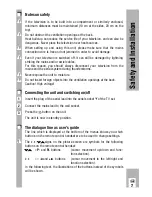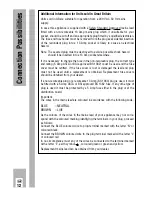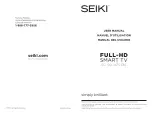
r
Notes on safety
Ń
!
If the television is to be built into a compartment or similarly enclosed,
minimum distances must be maintained (10 cm at the sides, 20 cm on the
top).
Ń
!
Do not obstruct the ventilation openings at the back.
Heat build-up can reduce the service life of your television, and can also be
dangerous. Never place the television near heat sources.
Ń
!
When setting up and using this unit, please make sure that the mains
connection wire is free and not jammed in order to avoid damage.
Ń
!
Even if your television is switched off, it can still be damaged by lightning
striking the mains and/or aerial cables.
For this reason, you should always disconnect your television from the
mains and the aerial system during thunderstorms.
Ń
!
Never expose the unit to moisture.
Ń
!
Do not insert foreign objects into the ventilation openings at the back.
Caution! High voltage!
r
Connecting the unit and switching on/off
Insert the plug of the aerial lead into the aerial socket
É
of the TV set.
Connect the mains lead to the wall socket.
Press the
¢
IO
button on the unit.
The unit is now in standby position.
r
The dialogue line as user’s guide
The line which is displayed at the bottom of the menus shows you which
buttons on the remote control handset are to be used to change settings.
Ń
!
The
ɦ
,
ɼ
,
ʺʺ
,
ɶɶ
signs on the picture screen are symbols for the following
buttons on the remote control handset:
ʺʺ
,
ɶɶ
=
P-
and
P+
buttons
(cursor movement up/down and func-
tion selection).
ɦ
,
ɼ
=
–
ņ
and
+
ŀ
buttons
(cursor movement to the left/right and
function selection).
In the following text, the illustrations of the buttons instead of the symbols
will be shown.
3
2
1
Safety and Installation
ķ
7


























